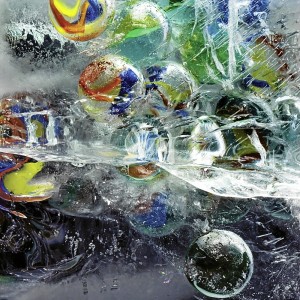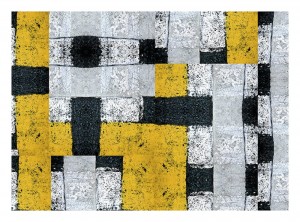
His latest works explore the photomontage, a series of photographs of common scenes such as cracks and paints on the roads and walls. They are taken from different angles, light exposures and at different times. By arranging and overlapping them, without any Photoshop, he is able to transform the shapes and textures into seamlessly-blended, graphic abstractions.
“It’s about 60 to 80 photographs—cement, parking lot, construction site, cart with lettering, a wall. I photograph, go home and join them together as in a puzzle,” says Epperson. “I took the things that we don’t pay attention to; we don’t give them a second thought; deconstruct and reconstruct them.”
Epperson’s favorite work is a photocollage of the paints indicating slots for the car that results in a Mondrian-like play of squares and rectangles in different sizes done in a restrained palette.
The photographer says he was inspired by two artists. When he was in Batanes, he was impressed with the art of Pacita Abad, with her playful collage of squares and circles in vivid colors.
A surfer since he was 11, Epperson also admires surfer-artist Wolfgang Bloch who integrates various media to produce mood paintings that transform ocean waves, sea skies into an ethereal fusion of color and shape.
“He uses something else to interpret something else,” explains Epperson. “His works were also the inspiration in the way he breaks things up and creates them into shapes. There’s no Photoshop outside of the fact that I took the photos and pieced them together.”
Epperson shows an abstraction of black and white shapes from the textures of the street with washes of yellow which were in real life yellow flowers on the road. “It’s got a nice Japanese feel and there’s no right way to hang it.”
With his keen eye, he would photograph the distressed surfaces of the metal covers on the road, rusting steel and black spots on the white road to make unusual yet very quieting patterns.
One of his most popular works were a deconstruction of cranes. He took several of them in various exposures on a muggy day with no skies. The black-and-white composite of their skeletal forms looked like pen-and-ink strokes.
The works took him two years from concept to production. While taking photographs, Epperson would be pestered by the security guards asking if he had a permit to shoot. “I’m photographing the road,” he would retort.
Working on an image took several days to perfect. Majority are three feet by three feet. To really enjoy these photocollages, you need to see them up close, as they are in a large format. Their impact is derived from the sense of space and immersion.
Epperson plans to do another experiment using the icon of the walking man in the pedestrian traffic light. “You figure out how to put things together and the palette will be red, blue and black.”
A few months earlier, Epperson ventured into another theme inspired by a trip to Mongolia and its frozen lakes. He first produced images of frozen flowers floating on ice. Businessman Marcel Crespo was enamored by the subject that he purchased his work.
One day, a gallery owner from New York flew to Manila to scout for talent. After visiting the galleries, nothing had caught his fancy until he had dinner with Crespo who showed him Epperson’s work.
The owner invited Epperson to exhibit at the Tyler Robbins Fine Art gallery with the theme of cultural images frozen in ice.
Although an American, he has been living in the Philippines for over decades and is married to a Filipina, columnist and style maven Jenni Epperson. As in his photocollages, he used familiar objects and Filipino symbols, such as the fan, rosary, sampaguita, balisong and toys and froze them in a temperature below 12 degrees, hence the title “12 Below.”
As these objects were immersed in blocks of ice, the deflection of a single light source made the object come alive, as if floating on layers of broken prisms. The setup made more impact as the viewer is confronted to look into their meaning.
One of the most striking works is “Pilikmata ng Kambing” (Goat’s Eyelash), a ring of goat hair used by men. When silver-haired women saw his photo at the New York gallery, they engaged Epperson in a conversation about its purpose and size.
The exhibit was also shown at the Nova Gallery. “Each object required a different process,” says the photographer. Jenni’s Barbie doll was supported by counterweights; the Chrysler car was rigged and marbles were glued so they wouldn’t sink.
“You have to freeze a block of ice, pour marbles and another block of ice. It’s the way I lit it. I got the marbles distorted and the ices broken. There were ripples on it.”
For his next collection, Epperson further shows his mastery of technique in artistic effect by capturing the elusive quality of smoke and presenting it a manner that surprises the viewer.
Epperson’s photomontages are on view at the Now Gallery. Unit M-05 Mezzanine, Ecoplaza, 2305 Chino Roces Ave. Extension. The “12 Below” works could be asked at the Nova Gallery,Warehouse 12A La Fuerza Compound, 2241 Chino Roces Ave., Makati City.

